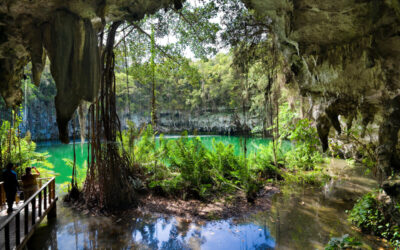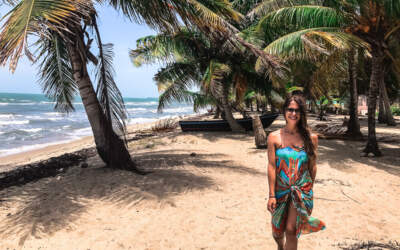Biodiversity like nowhere else on earth
Duration: at least one week
Ecuador’s amazonas are some of the most biodiverse in the world, and a visit there is unlike any other wildlife experience. Whereas in Africa you might travel by jeep to see animals in the savannah, or by boat to go whale watching, in Ecuador you have to travel on foot or by small boat.
This means that the wildlife is all around you and yet might be difficult to spot. However, this also makes Ecuador’s Amazonian region a genuinely immersive experience. You can’t help but feel like you’re a part of the ecosystem rather than just an observer. We observed the wild nature with absolute awe, but we also felt a bit uneasy at times. When sleeping, eating, and living in the middle of the jungle, you naturally encounter many wild animals and insects. We hoped the tarantula crawling on the ceiling above our heads had no intention of coming down to us
However, you’ll be rewarded with sightings of everything from monkeys and sloths to exotic birds and reptiles. It’s an unforgettable experience and one that will stay with you long after you’ve left Ecuador. There are two ways to go about your adventure in Ecuador’s rainforest. You can either go on a multiple-day tour to the Cuyabenyo Wildlife Reserve or base yourself in Tena and venture out there

Cuyabeno Wildlife Reserve
Cuyabeno Wildlife Reserve is Ecuador’s second largest national park and a mecca for wildlife enthusiasts. “The land between waters,” as looks call it, can only be visited on a guided tour ranging from 3-5 days. Though we are not always the biggest fan of tours, our 4- day journey was one of our biggest travel highlights!
Cuyabeno’s pristine wetland is home to over 500 species of birds, ten different types of monkeys, anacondas, caimans, jaguars, pink river dolphins, manatees, and a variety of fish, including arapaima and piranhas. The sounds, smells, and intensity of the jungle can’t be put into words!
On top of the fantastic wildlife experience, you can also learn about sustainable eco-tourism at local family farms, where they offer tours and teach visitors how to prepare traditional yucca bread made by their neighbors – the SIONA tribe living nearby.
Wildlife in Ecuador's rainforests
Many rainforest animals are still unknown to science, and new species are always being discovered. The forest floor contains insects, spiders, rodents, snakes, and lizards. You’ll find monkeys, sloths, toucans, and macaws in the trees. And there are caiman, piranhas, anacondas, and river dolphins in the rivers.
If you’re lucky, you might even spot a jaguar or an Amazonian tree boa.


Visit the SIONA tribe in Cuyabeno
The Siona tribe is one of the many indigenous tribes that live in the Cuyabeno Wildlife Reserve. The Siona people have lived in the rainforest for centuries, and they have a deep respect for nature.
The Siona tribe is known for its beautiful hand-woven fabrics and baskets, which they sell to tourists. They also offer rainforest tours, where you can learn about plants and animals.
If you visit the Cuyabeno Wildlife Reserve, be sure to take a tour with a member of the Siona tribe! You’ll not only learn so much about this amazing place but also support its inhabitants.
Land between waters
The Cuyabeno Wildlife Reserve is home to an incredible variety of plant and animal life. But what sets it apart is its water system. The reserve is crisscrossed by a network of rivers, lakes, and creeks teeming with fish, turtles, caiman, and other aquatic creatures. And when the sun goes down, the rivers come alive with hundreds of fireflies flickering in the darkness. It’s truly a magical sight. By the way: the sunsets in Cuaybeno are out of this world beautiful!

Practical travel tips for your round trip to Ecuador
What language is spoken in Ecuador?
Spanish!
What is the best time to travel to Ecuador?
The best time to travel to Ecuador depends on individual preferences and the activities planned.
In general, however, it can be said that the dry season from June to September is a good time to travel to Ecuador. There is less rain during this time, which makes hiking in the Andes and exploring the Amazon easier.
The months of December to January are also popular, as the weather is warm and pleasant, but there is more rain in the coastal and Amazon regions.
For those wishing to visit the Galápagos Islands, the months of June to November are ideal, as the sea is calmer and the wildlife viewing is optimal. However, it is important to note that the weather in Ecuador can vary greatly depending on the region, so it is advisable to find out in advance about the specific climatic conditions for the desired destinations.
Is Ecuador safe?
Ecuador has long been considered a safe country to travel to. The situation has currently deteriorated considerably. Carefree travel will be very difficult in 2024.
What is the currency in Ecuador?
The official currency in Ecuador is the US dollar (USD).
Public transportation in Ecuador
Public transportation is not only cheap, but also a very convenient way to get around Ecuador. You should try it out!
Public buses: The bus stop for buses that go practically everywhere from every major city. I couldn't find a schedule. They seem to travel more frequently than the Knutsford.
Knutsford: The luxury bus from Jamaica connects other important destinations. Please note that the specified time refers to the calculated travel time and
not
the actual time it takes to achieve a goal. In addition to the journey time, there are also stops and bus changes that are not visible when you buy your ticket. There are fewer buses than usual because of Covid, and it is better to use the Ticket online.
Internet and sim cards in Ecuador
Getting a local sim card in Ecuador is really easy and definitely worth it if you're planning to stay in the country for more than a week or two.
I normally use Claro, one of the biggest suppliers here. Just have a copy of your passport ready when you buy your SIM card.
The tariffs are quite favorable.
Can I drink the tap water in Ecuador?
In Quito you can safely drink the tap water. Even if it is not of the best quality and can be contaminated by the old pipes. The water is also treated with chlorine. A water filter is highly recommended in rural areas.
What should I look out for on my trip?
Trash can: As everywhere in South America, street food causes a lot of waste. Bring your foldable food container and cutlery. Don't forget your water filter.
Sunscreen: Protect Ecuador's marine life by using reef-friendly sunscreen.
Ecuador Rainforest Lodges
Yarina Ecolodge
Yarina Ecolodge is the only lodge beside the Napo Wildlife Center that can claim to be in Parque Nacional Yasuní, and it’s a much cheaper alternative. The lodge sits within the Kichwa community village on the Río Napo, so staying here allows you to meet community members.
Napo Wildlife Center
The center is owned by the local Kichwa community, and most of its employees are members of the community. The Napo Wildlife Center is unique among other jungle accommodations because visitors arrive not by motorized canoe but by an atmospheric paddle up a blackwater tributary away from the main river, the Río Napo. The eco-friendly project is committed to conservation and sustainable tourism.
Traveling Ecuador?
Ecuador ItineraryPlaces to visit in Ecuador
Dive into a land of contrasts!
Diving in Zanzibar
Duration: at least ten days Where to Stay: Sunshine Marine Lodge or Sunshine Azure It only took one backwards roll off a wooden dhow in Matemwe for me to fall—quite literally—head over fins for Zanzibar’s reefs. I’d signed up with Dive Point Zanzibar to earn my...
Two weeks Tanzania itinerary
I’ve returned to Tanzania time and again, and this two-week itinerary brings together my favorite moments — lively markets in Dar es Salaam, game drives in Ngorongoro and the Serengeti, and lazy days on the beaches of Zanzibar or Mafia Island
Over-tourism- how traveling affects the world
Traveling has become a mega industry in recent years and continues to grow. Usually, it is also one of our favorite things to write about. Yet, we feel like it’s time to express some concerns and worries.
Best places to stay in Jamaica
Where to stay in Jamaica- Saint Lucia at a Glance - Key areas - My Top Hotel Choices - North - South and Soufiere - East Coast - Castries - Budget Stays - Sustainable Stays - During Carnival - For couples -Beach StaysDuration: at least 3 weeks Best time to travel:...
Level 8 Luggage Review
Level 8 Luggage Review -Quick Verdict Pros and Cons - Who will love it? - Product Overview - My experience - Alternatives Is the Level 8 Worth It? Yes! It is absolutly built to solve real travel problems! After switching to the Level8 Adventure Carry-On, I...
LARQ Water Bottle Review: Honest Insights on Purification and Filtration
Curious about the LARQ water bottle? In this review, I share my personal experience testing the LARQ Bottle PureVis™ 2, including its UV-C purification, filtration features, and whether it’s worth the investment for safe, clean water on the go.
Day trips from Santo Domingo
Explore 5 unforgettable day-trips from Santo Domingo—all within a 2-hour drive. Swim turquoise bays, explore limestone caves, wander medieval villages & vibrant local markets.
Best gifts for travelers
Choosing the best gifts for travelers is more than a shopping task—it’s an act of kindness that enriches someone’s journey. From compact eco-friendly essentials to personalized tracking devices and splurge-worthy tech, there’s a perfect pick for every explorer and...
Where to Stay in Belize: Your Ultimate Guide
Discover where to stay in Belize: from eco‑friendly jungle lodges and boutique beachfront cabanas to secluded treehouse retreats.
Best gifts for travelers | Digital nomad edition
Choosing the best gifts for travelers is more than a shopping task—it’s an act of kindness that enriches someone’s journey. From compact eco-friendly essentials to personalized tracking devices and splurge-worthy tech, there’s a perfect pick for every explorer and...









